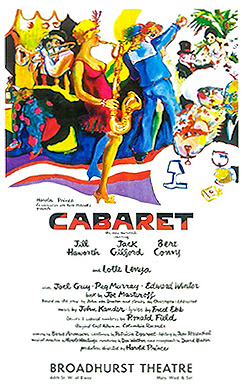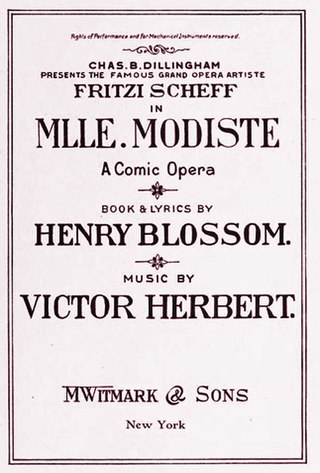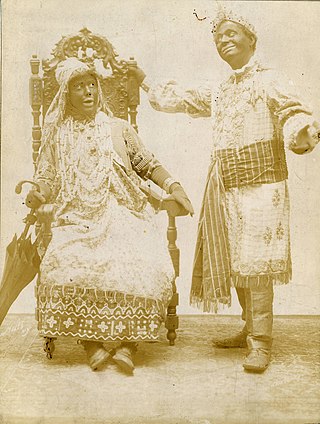Related Research Articles

Jean Schwartz was a Hungarian-born Jewish American composer and pianist. He is best known for his work writing the scores for more than 30 Broadway musicals, and for his creation of more than 1,000 popular songs with the lyricist William Jerome. Schwartz and Jerome also performed together on the vaudeville stage in the United States; sometimes in collaboration with Maude Nugent, Jerome's wife, and the Dolly Sisters. Schwartz was married to Jenny Dolly from 1913 to 1921.

Cabaret is a musical with music by John Kander, lyrics by Fred Ebb, and a book by Joe Masteroff. It is based on the 1951 play I Am a Camera by John Van Druten, which in turn was based on the 1939 novel Goodbye to Berlin by Christopher Isherwood.

Gay Divorce is a musical with music and lyrics by Cole Porter and book by Dwight Taylor, adapted by Kenneth Webb and Samuel Hoffenstein. It was Fred Astaire's last Broadway show and featured the hit song "Night and Day" in which Astaire danced with co-star Claire Luce.

The Producers is a musical comedy with music and lyrics by Mel Brooks, and a book by Brooks and Thomas Meehan. It is adapted from Brooks's 1967 film of the same name. The story concerns two theatrical producers who scheme to get rich by fraudulently overselling interests in a Broadway musical designed to fail. Complications arise when the show is a surprise hit. The humor of The Producers draws on exaggerated accents, caricatures of Jews, gay people and Nazis, and many show business in-jokes.

Mlle. Modiste is an operetta in two acts composed by Victor Herbert with a libretto by Henry Blossom. It concerns hat shop girl Fifi, who longs to be an opera singer, but who is such a good hat seller that her employer, Mme. Cecil, discourages her in her ambitions and exploits her commercial talents. Also, Fifi loves Etienne de Bouvray, who returns her love, but his uncle, Count Henri, opposes their union. The operetta features the song "Kiss Me Again".

Paul Frederick Jabara, was an American actor, singer, and songwriter. He was born to a Lebanese family in Brooklyn, New York. He wrote Donna Summer's Oscar-winning "Last Dance" from Thank God It's Friday (1978), as well as "No More Tears ", Summer's international hit duet with Barbra Streisand. He also co-wrote the Weather Girls' iconic hit "It's Raining Men" with Paul Shaffer.

The Knickerbocker Theatre, previously known as Abbey's Theatre and Henry Abbey's Theatre, was a Broadway theatre located at 1396 Broadway in New York City. It operated from 1893 to 1930. In 1906, the theatre introduced the first moving electrical sign on Broadway to advertise its productions.
Henry Martyn Blossom Jr. was an American writer, playwright, novelist, opera librettist, and lyricist. He first gained wide attention for his second novel, Checkers: A Hard Luck Story (1896), which was successfully adapted by Blossom into a 1903 Broadway play, Checkers. It was Blossom's first stage work and his first critical success in the theatre. The play in turn was adapted by others creatives into two silent films, one in 1913 and the other in 1919, and the play was the basis for the 1920 Broadway musical Honey Girl. Checkers was soon followed by Blossom's first critical success as a lyricist, the comic opera The Yankee Consul (1903), on which he collaborated with fellow Saint Louis resident and composer Alfred G. Robyn. This work was also adapted into a silent film in 1921. He later collaborated with Robyn again; writing the book and lyrics for their 1912 musical All for the Ladies.

The Band Wagon is a musical revue with book by George S. Kaufman and Howard Dietz, lyrics also by Dietz and music by Arthur Schwartz. It first played on Broadway in 1931, running for 260 performances. It introduced the song "Dancing in the Dark" and inspired two films.
Around the Clock is a musical in three acts with music by Lee Orean Smith, a book by Steve B. Cassin, and lyrics by J. Sebastian Hiller. The work was created as a starring vehicle for the Scottish comedian Billie Ritchie. A successful "road musical" which premiered in 1906, the work toured extensively for several years for performances in the United States and Europe; including two stints at theaters on Broadway in 1906 and 1908. The show was still touring as late as 1913. Set in Philadelphia, the loose plot takes place inside a music hall and on a vaudeville stage.

Parade is a musical revue with book, music, and lyrics by Jerry Herman.
The Prima Donna is a comic opera in two acts with music by Victor Herbert and a libretto by Henry Blossom. Written as a starring vehicle for Fritzi Scheff, the work premiered at the Studebaker Theater in Chicago on October 5, 1908. The production moved to Broadway where it had its New York City debut at the Knickerbocker Theatre on November 30, 1908. It ran at that theatre for total of 72 performances; closing on January 30, 1909. The original production was produced by Charles Dillingham, staged by Fred G. Latham, and conducted by musical director John Lund. The sets were designed by Homer Emens, and the costumes were created by Elsie de Wolfe. The leading cast included Fritzi Scheff as Mlle. Athenee, a.k.a "The Prima Donna"; Donald Hall as her love interest, Lieutenant Fernand Drouillard; William K. Harcourt as Athenee's thwarted suitor, Captain Bordenave; James E. Sullivan as the French music hall impresario, Herr Max Gundelfinger; and W. J. Ferguson as Athenee's father, Monsieur Beaurivage.
Louis De Lange, also known as Louis De Lange Moss was an American playwright, actor, and theatrical manager. As a stage actor he primarily appeared in light operas and musicals; notably portraying Sir Joseph Porter in the original production of John Philip Sousa's pirated version of Gilbert and Sullivan's H.M.S. Pinafore in Philadelphia, on Broadway and on tour in 1879. As a dramatist he mainly wrote the books for musicals; often in collaboration with writer Edgar Smith on projects created for the comedy duo Lew Fields and Joe Weber. De Lange also worked as Fields and Weber's manager for their national tours. His wife was the Broadway actress Selma Mantell who appeared in the Ziegfeld Follies among other Broadway shows. Their son was the bandleader and lyricist Eddie DeLange.
Ernest Albert, born Ernest Albert Brown, was an American painter, illustrator, muralist, and scenic designer. He was a prolific scenic designer, first in St. Louis and Chicago and then on Broadway. He is considered a major American landscape painter and was elected the first president of the Allied Artists of America in 1919.
The Gingerbread Man is a musical in two acts with music by A. Baldwin Sloane and both book and lyrics by Frederic Ranken. Described by the creators as a "Fanciful Fairyesque", the work was essentially a Christmas musical with Santa Claus and Mrs. Claus serving as the heroes of the piece.
Maurice Hegeman was an American musical theatre actor, playwright, librettist, and the inventor of the Brooklyn cocktail. He wrote the book and lyrics for the road musical Gay New York (1905), and starred in several Broadway productions produced by Florenz Ziegfeld Jr.

The Ham Tree is a "musical vaudeville" in three acts with music by Jean Schwartz, lyrics by William Jerome, and a book by George V. Hobart. A popular success from its debut in 1905, the work toured for several years; including three separate runs on Broadway. The work was created as a starring vehicle for vaudeville and minstrel show stars James McIntyre and Thomas Heath who were known for their work as blackface performers. The work incorporated several of their prior popular routines and sketches from their work on the vaudeville stage in order to appeal to their fan base. The concept of a "ham tree", along with other humorous trees like an "egg tree", was a repeating gag in their works dating back to their performances in The Georgia Minstrels in the 1890s and early 1900s. Following its initial tour, the work was revived by McIntyre and Heath several times, and was later heavily revised and retitled Hello, Alexander for a Broadway staging in 1919.
A Yankee Circus on Mars is a musical in two scenes with music by Manuel Klein and Jean Schwartz, lyrics by Harry Williams, and a book by George V. Hobart. It was one of four works presented together for the grand opening of Broadway's New York Hippodrome; the others being a collection of circus acts known as Circus Tournament, the ballet Dance of the Hours, and the war drama The Raiders by playwright Carroll Fleming. These four works were performed together for the Hippodrome's first public performance on April 12, 1905. Produced by Frederic W. Thompson and Elmer S. Dundy, A Yankee Circus on Mars continued to play together with these other works at the Hippodrome for 296 performances; closing on December 9, 1905. These works then toured the United States together; beginning a national tour in Chicago in February 1906.
Sunny Days is a musical in three acts with music by Jean Schwartz and both book and lyrics by Clifford Grey and William Carey Duncan. The musical was an adaptation of Grey's earlier stage play A Kiss in a Taxi which was in turn adapted from Maurice Hennequin and Pierre Veber's Le Monsieur de cinq heures. The work premiered at Broadway's Imperial Theatre on February 8, 1928. It ran there for a total of 101 performances; closing on May 5, 1928. The cast included Jeanette MacDonald as Ginette Bertin, Frank McIntyre as Leon Dorsay, Billy B. Van as Rudolph Max, Lynne Overman as Maurice Vane, Rosalie Claire as Angele Larue, and Audrey Maple as Madame Dorsay.